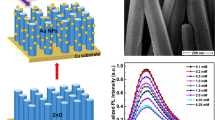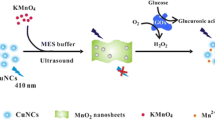Abstract
The accurate detection of blood glucose is of critical importance in the diagnosis and management of diabetes and its complications. Herein, we report a novel strategy based on an upconversion nanoparticles-polydopamine (UCNPs-PDA) nanosystem for the accurate detection of glucose in human serum and whole blood through a simple blending of test samples with ligand-free UCNPs, dopamine, and glucose oxidase (GOx). Owing to the high affinity of lanthanide ions exposed on the surface of ligand-free UCNPs, dopamine monomers could spontaneously attach to the UCNPs and further polymerize to form a PDA shell, resulting in a remarkable upconversion luminescence (UCL) quenching (97.4%) of UCNPs under 980-nm excitation. Such UCL quenching can be effectively inhibited by H2O2 produced from the GOx/glucose enzymatic reaction, thus enabling the detection of H2O2 or glucose based on the UCL quenching/inhibition bioassay. Owing to the highly sensitive UCL response and background-free interference of the UCNPs-PDA nanosystem, we achieved a sensitive, selective, and high-throughput bioassay for glucose in human serum and whole blood, thereby revealing the great potential of the UCNPs-PDA nanosystem for the accurate detection of blood glucose or other H2O2-generated biomolecules in clinical bioassays.

Similar content being viewed by others
References
Heller, A.; Feldman, B. Electrochemical glucose sensors and their applications in diabetes management. Chem. Rev. 2008, 108, 2482–2505.
Harris, M. Classification and diagnosis of diabetes mellitus and other categories of glucose intolerance. Diabetes 1979, 28, 1039–1057.
American Diabetes Association. Diagnosis and classification of diabetes mellitus. Diabetes Care 2014, 37, S81–S90.
Alberti, K. G. M. M.; Zimmet, P. Z.; Consultation, W. Definition, diagnosis and classification of diabetes mellitus and its complications. Part 1: Diagnosis and classification of diabetes mellitus. Provisional report of a WHO consultation. Diabet. Med. 1998, 15, 539–553.
Xiong, Y. M.; Zhang, Y. Y.; Rong, P. F.; Yang, J.; Wang, W.; Liu, D. B. A high-throughput colorimetric assay for glucose detection based on glucose oxidase-catalyzed enlargement of gold nanoparticles. Nanoscale 2015, 7, 15584–15588.
Clarke, S. E.; Foster, J. R. A history of blood glucose meters and their role in self-monitoring of diabetes mellitus. Br. J. Biomed. Sci. 2012, 69, 83–93.
Trajanoski, Z.; Brunner, G. A.; Gfrerer, R. J.; Wach, P.; Pieber, T. R. Accuracy of home blood glucose meters during hypoglycemia. Diabetes Care 1996, 19, 1412–1415.
Liu, Q. Y.; Yang, Y. T.; Li, H.; Zhu, R. R.; Shao, Q.; Yang, S. G.; Xu, J. J. NiO nanoparticles modified with 5,10,15,20-tetrakis(4-carboxylpheyl)- porphyrin: Promising peroxidase mimetics for H2O2 and glucose detection. Biosens. Bioelectron. 2015, 64, 147–153.
Zhang, J. X.; Tu, L. P.; Zhao, S.; Liu, G. H.; Wang, Y. Y.; Wang, Y.; Yue, Z. Fluorescent gold nanoclusters based photoelectrochemical sensors for detection of H2O2 and glucose. Biosens. Bioelectron. 2015, 67, 296–302.
Lu, L. F.; Li, Y. Y.; Zhang, M.; Shi, G. Y. Visual fluorescence detection of H2O2 and glucose based on “molecular beacon”-hosted Hoechst dyes. Analyst 2015, 140, 3642–3647.
Liu, B. W.; Sun, Z. Y.; Huang, P. J. J.; Liu, J. W. Hydrogen peroxide displacing DNA from nanoceria: Mechanism and detection of glucose in serum. J. Am. Chem. Soc. 2015, 137, 1290–1295.
Wang, D.; Wang, R. H.; Liu, L. J.; Qu, Y.; Wang, G. F.; Li, Y. D. Down-shifting luminescence of water soluble NaYF4:Eu3+@Ag core-shell nanocrystals for fluorescence turn-on detection of glucose. Sci. China Mater. 2017, 60, 68–74.
Medintz, I. L.; Uyeda, H. T.; Goldman, E. R.; Mattoussi, H. Quantum dot bioconjugates for imaging, labelling and sensing. Nat. Mater. 2005, 4, 435–446.
Resch-Genger, U.; Grabolle, M.; Cavaliere-Jaricot, S.; Nitschke, R.; Nann, T. Quantum dots versus organic dyes as fluorescent labels. Nat. Methods 2008, 5, 763–775.
Zheng, W.; Huang, P.; Tu, D. T.; Ma, E.; Zhu, H. M.; Chen, X. Y. Lanthanide-doped upconversion nano-bioprobes: Electronic structures, optical properties, and biodetection. Chem. Soc. Rev. 2015, 44, 1379–1415.
Wang, J. W.; Tanner, P. A. Upconversion for white light generation by a single compound. J. Am. Chem. Soc. 2010, 132, 947–949.
Zhou, B.; Shi, B. Y.; Jin, D. Y.; Liu, X. G. Controlling upconversion nanocrystals for emerging applications. Nat. Nanotechnol. 2015, 10, 924–936.
Su, Q. Q.; Feng, W.; Yang, D. P.; Li, F. Y. Resonance energy transfer in upconversion nanoplatforms for selective biodetection. Acc. Chem. Res. 2017, 50, 32–40.
Tsang, M. K.; Ye, W. W.; Wang, G. J.; Li, J. M.; Yang, M.; Hao, J. H. Ultrasensitive detection of ebola virus oligonucleotide based on upconversion nanoprobe/nanoporous membrane system. ACS Nano 2016, 10, 598–605.
Liu, Y. Y.; Zhang, J. W.; Zuo, C. J.; Zhang, Z.; Ni, D. L.; Zhang, C.; Wang, J.; Zhang, H.; Yao, Z. W.; Bu, W. B. Upconversion nano-photosensitizer targeting into mitochondria for cancer apoptosis induction and cyt c fluorescence monitoring. Nano Res. 2016, 9, 3257–3266.
Xu, W.; Zhu, Y. S.; Chen, X.; Wang, J.; Tao, L.; Xu, S.; Liu, T.; Song, H. W. A novel strategy for improving upconversion luminescence of NaYF4:Yb,Er nanocrystals by coupling with hybrids of silver plasmon nanostructures and poly(methyl methacrylate) photonic crystals. Nano Res. 2013, 6, 795–807.
Huang, P.; Tu, D. T.; Zheng, W.; Zhou, S. Y.; Chen, Z.; Chen, X. Y. Inorganic lanthanide nanoprobes for background-free luminescent bioassays. Sci. China Mater. 2015, 58, 156–177.
Luo, W. Q.; Liu, Y. S.; Chen, X. Y. Lanthanide-doped semiconductor nanocrystals: Electronic structures and optical properties. Sci. China Mater. 2015, 58, 819–850.
Lu, S.; Tu, D. T.; Li, X. J.; Li, R. F.; Chen, X. Y. A facile “ship-in-a-bottle” approach to construct nanorattles based on upconverting lanthanide-doped fluorides. Nano Res. 2016, 9, 187–197.
Liu, J. L.; Lu, L. L.; Li, A. Q.; Tang, J.; Wang, S. G.; Xu, S. Y.; Wang, L. Y. Simultaneous detection of hydrogen peroxide and glucose in human serum with upconversion luminescence. Biosens. Bioelectron. 2015, 68, 204–209.
Yuan, J.; Cen, Y.; Kong, X. J.; Wu, S.; Liu, C. L.; Yu, R. Q.; Chu, X. MnO2-nanosheet-modified upconversion nanosystem for sensitive turn-on fluorescence detection of H2O2 and glucose in blood. ACS Appl. Mater. Interfaces 2015, 7, 10548–10555.
Wu, S.; Kong, X. J.; Cen, Y.; Yuan, J.; Yu, R. Q.; Chu, X. Fabrication of a LRET-based upconverting hybrid nanocomposite for turn-on sensing of H2O2 and glucose. Nanoscale 2016, 8, 8939–8946.
Zhang, C. L.; Yuan, Y. X.; Zhang, S. M.; Wang, Y. H.; Liu, Z. H. Biosensing platform based on fluorescence resonance energy transfer from upconverting nanocrystals to graphene oxide. Angew. Chem., Int. Ed. 2011, 50, 6851–6854.
Lee, H.; Dellatore, S. M.; Miller, W. M.; Messersmith, P. B. Mussel-inspired surface chemistry for multifunctional coatings. Science 2007, 318, 426–430.
Ku, S. H.; Park, C. B. Human endothelial cell growth on mussel-inspired nanofiber scaffold for vascular tissue engineering. Biomaterials 2010, 31, 9431–9437.
Kang, S. M.; You, I.; Cho, W. K.; Shon, H. K.; Lee, T. G.; Choi, I. S.; Karp, J. M.; Lee, H. One-step modification of superhydrophobic surfaces by a mussel-inspired polymer coating. Angew. Chem., Int. Ed. 2010, 49, 9401–9404.
Liu, Y. L.; Ai, K. L.; Lu, L. H. Polydopamine and its derivative materials: Synthesis and promising applications in energy, environmental, and biomedical fields. Chem. Rev. 2014, 114, 5057–5115.
Swan, G. A. Chemical structure of melanins. Ann. N. Y. Acad. Sci. 1963, 100, 1005–1019.
Qiang, W. B.; Li, W.; Li, X. Q.; Chen, X.; Xu, D. K. Bioinspired polydopamine nanospheres: A superquencher for fluorescence sensing of biomolecules. Chem. Sci. 2014, 5, 3018–3024.
Tu, D. T.; Liu, Y. S.; Zhu, H. M.; Li, R. F.; Liu, L. Q.; Chen, X. Y. Breakdown of crystallographic site symmetry in lanthanide-doped NaYF4 crystals. Angew. Chem., Int. Ed. 2013, 52, 1128–1133.
Bogdan, N.; Vetrone, F.; Ozin, G. A.; Capobianco, J. A. Synthesis of ligand-free colloidally stable water dispersible brightly luminescent lanthanide-doped upconverting nanoparticles. Nano Lett. 2011, 11, 835–840.
Krämer, K. W.; Biner, D.; Frei, G.; Güdel, H. U.; Hehlen, M. P.; Lüthi, S. R. Hexagonal sodium yttrium fluoride based green and blue emitting upconversion phosphors. Chem. Mater. 2004, 16, 1244–1251.
Huang, P.; Zheng, W.; Zhou, S. Y.; Tu, D. T.; Chen, Z.; Zhu, H. M.; Li, R. F.; Ma, E.; Huang, M. D.; Chen, X. Y. Lanthanide-doped LiLuF4 upconversion nanoprobes for the detection of disease biomarkers. Angew. Chem., Int. Ed. 2014, 53, 1252–1257.
Wong, C. M.; Wong, K. H.; Chen, X. D. Glucose oxidase: Natural occurrence, function, properties and industrial applications. Appl. Microbiol. Biotechnol. 2008, 78, 927–938.
Shan, C. S.; Yang, H. F.; Song, J. F.; Han, D. X.; Ivaska, A.; Niu, L. Direct electrochemistry of glucose oxidase and biosensing for glucose based on graphene. Anal. Chem. 2009, 81, 2378–2382.
Zheng W.; Zhou S. Y.; Xu J.; Liu Y. S.; Huang P.; Liu Y.; Chen X. Y. Ultrasensitive luminescent in vitro detection for tumor markers based on inorganic lanthanide nano-bioprobes. Adv. Sci. 2016, 3, 1600197.
Wang, M.; Chen, Z.; Zheng, W.; Zhu, H. M.; Lu, S.; Ma, E.; Tu, D. T.; Zhou, S. Y.; Huang, M. D.; Chen, X. Y. Lanthanide-doped upconversion nanoparticles electrostatically coupled with photosensitizers for near-infrared-triggered photodynamic therapy. Nanoscale 2014, 6, 8274–8282.
Chen, H. Y.; Fang, A. J.; He, L.; Zhang, Y. Y.; Yao, S. Z. Sensitive fluorescent detection of H2O2 and glucose in human serum based on inner filter effect of squaric acidiron(III) on the fluorescence of upconversion nanoparticle. Talanta 2017, 164, 580–587.
Xiao, Y.; Zeng, L. Y.; Xia, T.; Wu, Z. J.; Liu, Z. H. Construction of an upconversion nanoprobe with few-atom silver nanoclusters as the energy acceptor. Angew. Chem., Int. Ed. 2015, 54, 5323–5327.
Li, Z.; Liang, T.; Lv, S. W.; Zhuang, Q. G.; Liu, Z. H. A rationally designed upconversion nanoprobe for in vivo detection of hydroxyl radical. J. Am. Chem. Soc. 2015, 137, 11179–11185.
Achatz, D. E.; Meier, R. J.; Fischer, L. H.; Wolfbeis, O. S. Luminescent sensing of oxygen using a quenchable probe and upconverting nanoparticles. Angew. Chem., Int. Ed. 2011, 50, 260–263.
Gorris, H. H.; Wolfbeis, O. S. Photon-upconverting nanoparticles for optical encoding and multiplexing of cells, biomolecules, and microspheres. Angew. Chem., Int. Ed. 2013, 52, 3584–3600.
Lin, J. H.; Yu, C. J.; Yang, Y. C.; Tseng, W. L. Formation of fluorescent polydopamine dots from hydroxyl radicalinduced degradation of polydopamine nanoparticles. Phys. Chem. Chem. Phys. 2015, 17, 15124–15130.
Shah, V. P.; Midha, K. K.; Findlay, J. W. A.; Hill, H. M.; Hulse, J. D.; McGilveray, I. J.; McKay, G.; Miller, K. J.; Patnaik, R. N.; Powell, M. L. et al. Bioanalytical method validation-a revisit with a decade of progress. Pharm. Res. 2000, 17, 1551–1557.
Wang, M.; Li, M.; Yang, M. Y.; Zhang, X. M.; Yu, A. Y.; Zhu, Y.; Qiu, P. H.; Mao, C. B. NIR-induced highly sensitive detection of latent fingermarks by NaYF4: Yb, Er upconversion nanoparticles in a dry powder state. Nano Res. 2015, 8, 1800–1810.
Acknowledgements
This work is supported by the National Basic Research Program of China (973 Program) (No. 2014CB845605), the National Natural Science Foundation of China (NSFC) (Nos. U1305244, 21325104, 51402294 and 21501180), the CAS/SAFEA International Partnership Program for Creative Research Teams, Strategic Priority Research Program of the CAS (Nos. XDA09030307 and XDB20000000), the Youth Innovation Promotion Association (No. 2016277) and the Chunmiao Project of Haixi Institute of the CAS (No. CMZX-2016-002), and the Natural Science Foundation of Fujian Province (Nos. 2015J05116, 2017J05095, 2017J01105 and 2017I0018).
Author information
Authors and Affiliations
Corresponding authors
Electronic supplementary material
12274_2017_1721_MOESM1_ESM.pdf
A strategy for accurate detection of glucose in human serum and whole blood based on an upconversion nanoparticles-polydopamine nanosystem
Rights and permissions
About this article
Cite this article
Liu, Y., Tu, D., Zheng, W. et al. A strategy for accurate detection of glucose in human serum and whole blood based on an upconversion nanoparticles-polydopamine nanosystem. Nano Res. 11, 3164–3174 (2018). https://doi.org/10.1007/s12274-017-1721-1
Received:
Revised:
Accepted:
Published:
Issue Date:
DOI: https://doi.org/10.1007/s12274-017-1721-1




